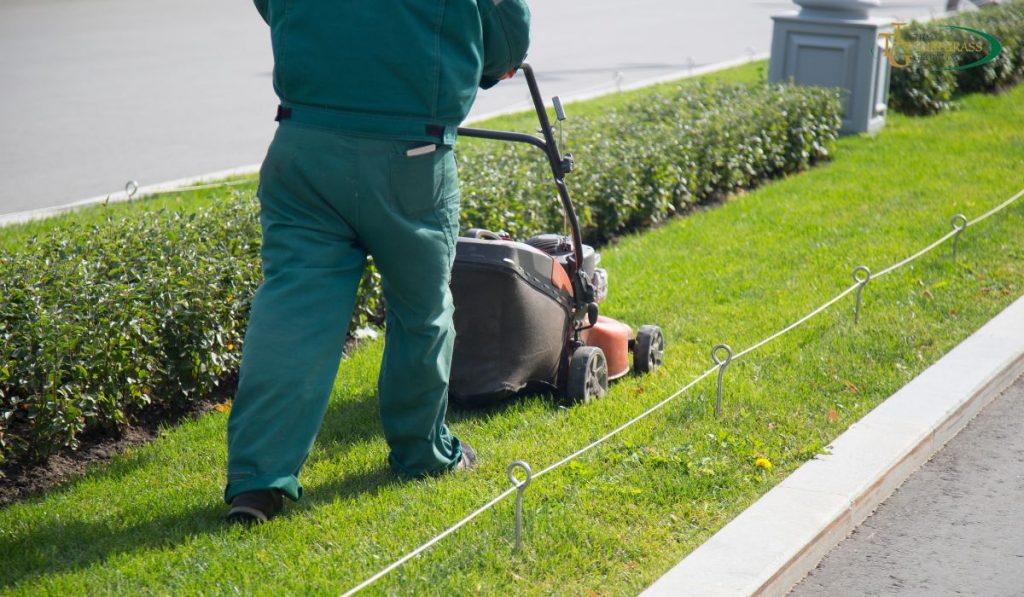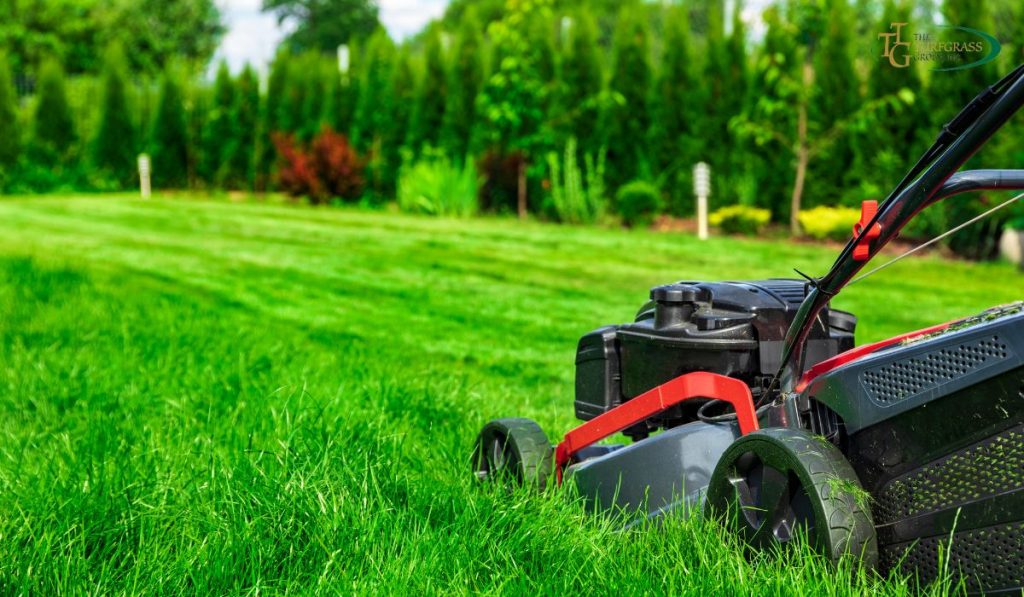
If you want to maintain a lush, healthy Bermuda grass lawn, one of the most important things you can do is mow your property at the proper height. Not only does the correct height help maintain a beautiful lawn, but it also plays a crucial role in the over all health of your grass.
In this blog, we’ll explore how to mow Bermuda grass at an optimal height, factors to consider for Bermuda grass mowing height, the best mowing height for Bermuda grass lawn, tips for mowing Bermuda lawn the right way, and how to adjust the grass cutting size for a lush, green Bermuda lawn.
Reasons For Moving Bermuda Grass At An Optimal Height
Mowing your Bermuda grass lawn at the right height has numerous benefits for your lawn’s health and appearance. First and foremost, pruning at the optimal height ensures that your grass gets enough sunlight, which is essential for healthy growth.
Additionally, mowing at the right height helps to promote profound root growth, which in turn helps to make your grass more drought-resistant. Regularly cutting at the correct size also helps prevent weeds from taking over your lawn and reduces the risk of lawn diseases.
Factors To Consider For Bermuda Grass Mowing Height
There are several factors to consider when deciding the optimal mowing height for your Bermuda grass lawn. These include:
- The variety of Bermuda grass you have: Different types of Bermuda grass have different optimal mowing sizes. Consult with a turfgrass professional or research to determine the correct mowing height for your Bermuda grass.
- The time of year: During the summer growing season, Bermuda grass can be mowed shorter than during the cooler months when the grass goes dormant.
- The frequency of mowing: If you mow your lawn frequently, you can afford to keep it shorter than if you only trim once every few weeks.
- The amount of sunlight your property receives: If it is shaded, it’s best to keep the grass a bit taller to ensure enough sunlight for healthy growth.

What Is The Best Mowing Height For Bermuda Grass Lawn?
So what is the best mowing height for your Bermuda grass lawn? As we mentioned, this can vary depending on our discussed factors. However, a good rule of thumb is to mow your Bermuda grass lawn to a height of between 0.5 and 2 inches, depending on your specific variety of Bermuda grass. Generally, keeping your Bermuda grass lawn shorter during the growing season and a bit taller during the dormant season is best.
Tips For Mowing Bermuda Lawn The Right Way
Now that you know the optimal mowing height for your Bermuda grass lawn, mowing the right way is essential to ensure the best results. Here are some tips to keep in mind:
- Ensure your lawn mower blades are sharp: Dull blades can damage your grass and make it more susceptible to disease.
- Only mow when your grass is dry: Wet grass can clog your mower and lead to uneven cutting.
- Don’t mow too much at once: It’s best to only remove about one-third of the blade height at a time to avoid damaging the grass.
- Vary your mowing pattern: Changing up your mowing design can help prevent grass from leaning in one direction and encourage even growth.
- Leave the clippings on the lawn: Grass can help fertilize your property and promote healthy growth.
Adjust The Grass Cutting Height For A Lush, Green Bermuda Lawn
Finally, remember that you may need to adjust the cutting height of your lawn mower depending on the time of year or weather conditions. For example, during a scorching and dry spell, you may want to raise the cutting height of your mower to allow your Bermuda grass to grow taller and retain more moisture. Similarly, you should lower the cutting height slightly during high rainfall to prevent the grass from becoming too tall and clumping together.
In addition to adjusting the cutting height, there are other things you can do to promote a lush, green Bermuda lawn. Regular fertilization and watering can keep your grass healthy and encourage growth. Aerate your lawn periodically to promote profound root growth and help water and nutrients reach the roots. And if you notice any bare spots in your property, consider overseeding with Bermuda grass seed to promote healthy growth and fill in gaps.
FAQ
Q: What is the ideal height to cut Bermuda grass for a healthy lawn?
A: The ideal height for cutting Bermuda grass is 0.5 to 1.5 inches. This height promotes a healthy root system and encourages a dense and lush lawn.
Q: How often should I mow my Bermuda grass lawn?
A: Bermuda grass proliferates, especially during the warm seasons. It is recommended to mow your Bermuda grass lawn once every 5 to 7 days to maintain the ideal height and prevent the grass from becoming too long.
Q: Should I vary the cutting height during different seasons?
A: It is advisable to adjust the cutting height based on the season. During the growing season, you can set the mower to the lower end of the recommended range (around 0.5 to 1 inch) for a well-maintained appearance. In the cooler seasons or during drought, you can raise the cutting height to the higher end of the range (around 1 to 1.5 inches) to provide more shade and protect the grassroots.
Q: Should I remove the clippings after mowing Bermuda grass?
A: It is generally recommended to leave the clippings on the lawn after mowing Bermuda grass. These clippings act as a natural mulch, returning valuable nutrients into the soil and helping to retain moisture. However, if the clippings are excessive and clumping, it is advisable to collect them to prevent suffocating the grass.
Q: What type of mower is best for cutting Bermuda grass?
A: A reel mower or a rotary mower with a sharp blade and adjustable cutting height settings is suitable for cutting Bermuda grass. Reel mowers provide a clean and precise cut, while rotary mowers work well for larger areas. Ensure the mower blade is sharp to avoid tearing or damaging the grass blades.

Q: Can I scalp my Bermuda grass lawn?
A: Scalping, which involves cutting the grass extremely short, is not recommended for Bermuda grass. Scalping can weaken the grass and make it more susceptible to stress, disease, and weed invasion. Maintaining a consistent and appropriate cutting height throughout the year is best.
Q: Should I water the lawn before or after mowing Bermuda grass?
A: It is generally better to water your Bermuda grass lawn before mowing rather than immediately after. Mowing on dry grass allows for a cleaner cut and reduces the risk of clumping or damaging wet grass blades. However, ensure that the soil is dry enough, as this can make mowing more challenging and put stress on the grass.
Q: Can I mow Bermuda grass when it’s dormant?
A: During dormancy, Bermuda grass turns brown and becomes dormant to survive extreme temperatures. Mowing static Bermuda grass is only necessary if it is within the recommended height. Wait until the grass starts actively growing again before resuming regular mowing.
Q: Should I use a specific mowing pattern for Bermuda grass?
A: While no specific mowing pattern is required for Bermuda grass, changing the mowing direction with each mow is recommended. Altering the design helps prevent the grass from leaning in one direction and promotes more upright growth.
Q: What additional lawn care practices should I follow for a healthy Bermuda grass lawn?
A: With proper mowing, ensure your Bermuda grass lawn receives adequate water, sunlight, and regular fertilization. Aeration and dethatching can also benefit the property by improving air circulation, water absorption, and nutrient uptake. Common weed control and proper irrigation practices contribute to a healthy and vibrant Bermuda grass lawn.
Conclusion
In conclusion, mowing your Bermuda grass lawn at the right height is essential for promoting healthy growth, preventing weeds and disease, and maintaining a beautiful property. By considering factors such as grass variety, time of year, and mowing frequency, you can determine the optimal mowing height for your Bermuda grass lawn. You can enjoy a lush, green Bermuda lawn all season long by following proper mowing techniques, adjusting the cutting size as needed, and being interested in growing a lush lawn. Reach out for a sod grower near you!